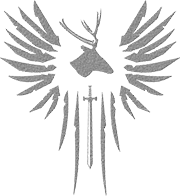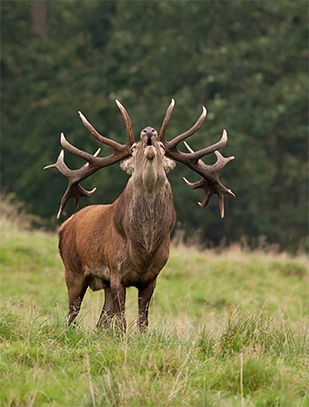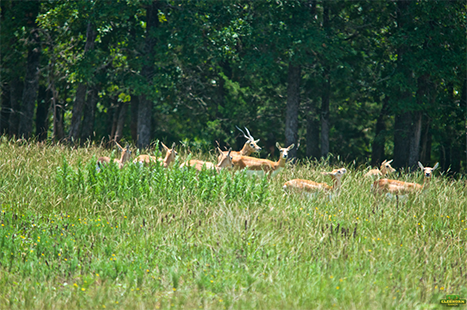- Written by Francisco Artes
- Published: 09 July 2018
RRed deer, is the fourth-largest deer species behind moose, elk and sambar deer. It is a ruminant, eating its food in two stages and having an even number of toes on each hoof, like camels, goats and cattle.
European red deer have a relatively long tail compared to their Asian and North American relatives. Subtle differences in appearance are noted between the various subspecies of red deer, primarily in size and antlers, with the smallest being the Corsican red deer found on the islands of Corsica and Sardinia and the largest being the Caspian red deer[8] (or maral) of Asia Minor and the Caucasus Region to the west of the Caspian Sea.
The deer of central and western Europe vary greatly in size, with some of the largest deer found in the Carpathian Mountains in Central Europe.[6] Western European red deer, historically, grew to large size given ample food supply (including people's crops), and descendants of introduced populations living in New Zealand and Argentina have grown quite large in both body and antler size. Large red deer stags, like the Caspian red deer or those of the Carpathian Mountains, may rival the wapiti in size. Female red deer are much smaller than their male counterparts.
European red deer tend to be reddish-brown in their summer coats. The males of many subspecies also grow a short neck mane during the autumn. The male deer of the British Isles and Norway tend to have the thickest and most noticeable manes. Male Caspian red deer (C. e. maral) and Spanish red deer (C. e. hispanicus) do not carry neck manes. Male deer of all subspecies, however, tend to have stronger and thicker neck muscles than female deer, which may give them an appearance of having neck manes. Red deer hinds (females) do not have neck manes. The European red deer is adapted to a woodland environment.
Only the stags have antlers, which start growing in the spring and are shed each year, usually at the end of winter. Antlers typically measure 28 in in total length and weigh 2.2 lb, although large ones can grow to 45 in and weigh 11 lb. Antlers, which are made of bone, can grow at a rate of 1" a day. A soft covering known as velvet helps to protect newly forming antlers in the spring. European red deer antlers are distinctive in being rather straight and rugose, with the fourth and fifth tines forming a "crown" or "cup" in larger males. Any tines in excess of the fourth and fifth tine will grow radially from the cup, which are generally absent in the antlers of smaller red deer, such as Corsican red deer. Western European red deer antlers feature "bez" (second) tines that are either absent or smaller than the brow tines. However, bez tines occur frequently in Norwegian red deer. Antlers of Caspian red deer carry large bez tines and form less-developed cups than western European red deer, their antlers are thus more like the "throw back" top tines of the wapiti (C. canadensis), known as maraloid characteristics. A stag can (exceptionally) have antlers with no tines, and is then known as a switch. Similarly, a stag that does not grow antlers is a hummel. The antlers are testosterone-driven and as the stag's testosterone levels drop in the autumn, the velvet is shed and the antlers stop growing.[12] With the approach of autumn, the antlers begin to calcify and the stags' testosterone production builds for the approaching rut (mating season).
During the autumn, all red deer subspecies grow thicker coats of hair, which helps to insulate them during the winter. Autumn is also when some of the stags grow their neck manes.[6] The autumn/winter coat of most subspecies are most distinct. The Caspian red deer's winter coat is greyer and has a larger and more distinguished light rump-patch (like wapiti and some central Asian red deer) compared to the Western European red deer, which has more of a greyish-brown coat with a darker yellowish rump patch in the winter. By the time summer begins, the heavy winter coat has been shed; the animals are known to rub against trees and other objects to help remove hair from their bodies. Red deer have different colouration based on the seasons and types of habitats, with grey or lighter colouration prevalent in the winter and more reddish and darker coat colouration in the summer.[13] Most European red deer have reddish-brown summer coats, and some individuals may have a few spots on the backs of their summer coats.
Useful Links
Contact Us
About
Valkyrie Ranch is conveniently located just 45 minutes east of Austin, Texas and less than 2 hours west of Houston, Texas and northeast of San Antonio, Texas.
Not only are we the home of Thorin's Viking Brands (Mead) and The Texas Viking Festival We offer camping, romantic retreats in our beautiful cabins, horseback riding, photography, and education.
We also are a venue for events such as art festivals, weddings, receptions, corporate retreats, trail riding clubs, etc.
Check out our wedding site at Valkyrie Weddings
Come visit our 500 acres of peaceful and secluded property!


